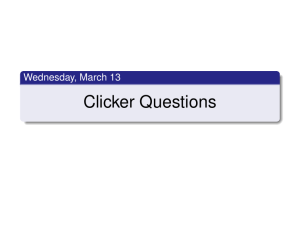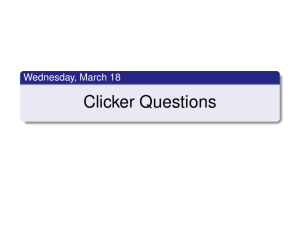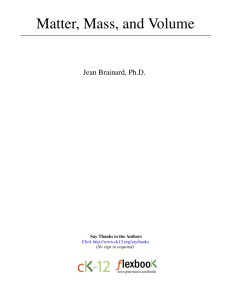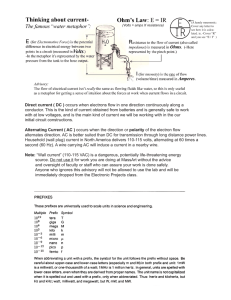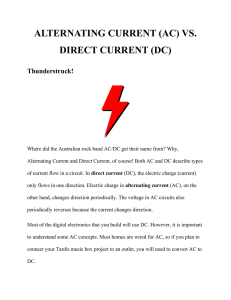Direct and Alternating Current
advertisement
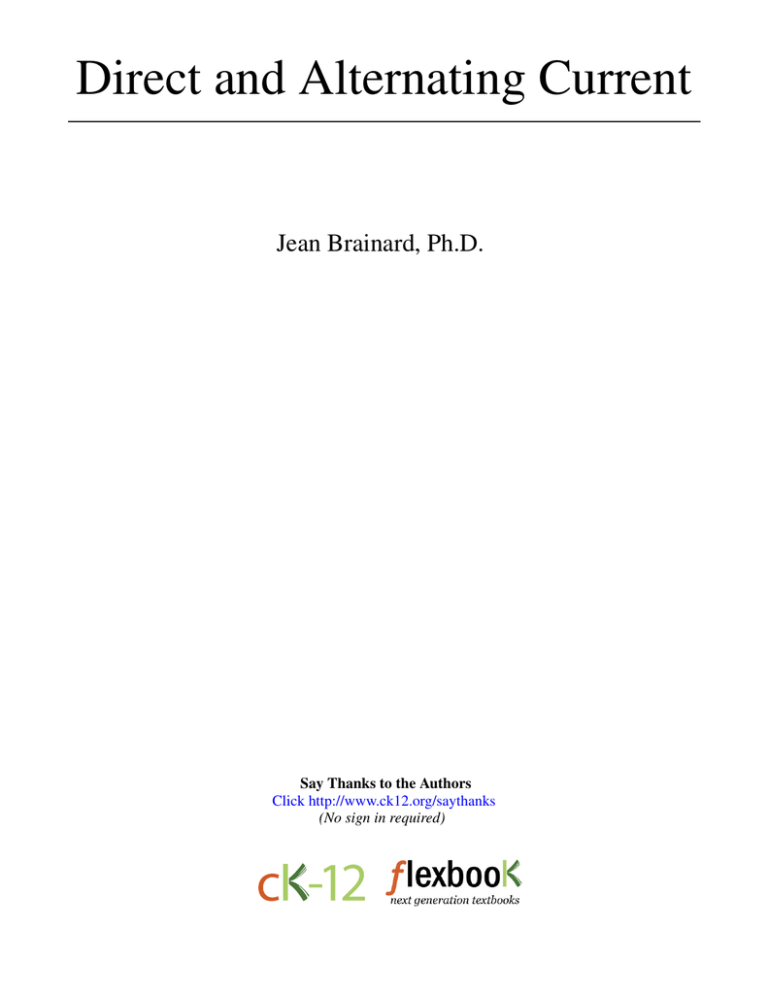
Direct and Alternating Current Jean Brainard, Ph.D. Say Thanks to the Authors Click http://www.ck12.org/saythanks (No sign in required) To access a customizable version of this book, as well as other interactive content, visit www.ck12.org CK-12 Foundation is a non-profit organization with a mission to reduce the cost of textbook materials for the K-12 market both in the U.S. and worldwide. Using an open-source, collaborative, and web-based compilation model, CK-12 pioneers and promotes the creation and distribution of high-quality, adaptive online textbooks that can be mixed, modified and printed (i.e., the FlexBook® textbooks). Copyright © 2015 CK-12 Foundation, www.ck12.org The names “CK-12” and “CK12” and associated logos and the terms “FlexBook®” and “FlexBook Platform®” (collectively “CK-12 Marks”) are trademarks and service marks of CK-12 Foundation and are protected by federal, state, and international laws. Any form of reproduction of this book in any format or medium, in whole or in sections must include the referral attribution link http://www.ck12.org/saythanks (placed in a visible location) in addition to the following terms. Except as otherwise noted, all CK-12 Content (including CK-12 Curriculum Material) is made available to Users in accordance with the Creative Commons Attribution-Non-Commercial 3.0 Unported (CC BY-NC 3.0) License (http://creativecommons.org/ licenses/by-nc/3.0/), as amended and updated by Creative Commons from time to time (the “CC License”), which is incorporated herein by this reference. Complete terms can be found at http://www.ck12.org/about/ terms-of-use. Printed: December 10, 2015 AUTHOR Jean Brainard, Ph.D. www.ck12.org C HAPTER Chapter 1. Direct and Alternating Current 1 Direct and Alternating Current • Distinguish between direct current and alternating current. To use an electric appliance, you have to plug it into an outlet unless it has batteries. This may be all you need to know in order to use electric current. But did you ever wonder what electric current is or how it flows through wires inside the walls of your home? Electric current is a continuous flow of electric charges. The charges may flow in just one direction, or they may keep reversing direction. You can watch an animation of both types of current at this URL: http://www.youtube.com/watch?v=JZjMuIHoBeg MEDIA Click image to the left or use the URL below. URL: http://www.ck12.org/flx/render/embeddedobject/5057 1 www.ck12.org Direct Current When current flows in just one direction, it is called direct current (DC). The diagram below shows how direct current flows through a simple circuit. An example of direct current is the current that flows through a batterypowered flashlight. In addition to batteries, solar cells and fuel cells can also provide direct current. Alternating Current When current keeps reversing direction, it is called alternating current (AC). You can see how it works in the two diagrams below. The current that comes from a power plant and supplies electricity to homes and businesses is alternating current. The current changes direction 60 times per second. It happens so quickly that the light bulb doesn’t have a chance to stop glowing when the reversals occur. Q: Which type of current flows through the wires in your home? A: Alternating current from a power plant flows through the wires in a home. Summary • Direct current (DC) keeps flowing in just one direction. Batteries provide direct current. 2 www.ck12.org Chapter 1. Direct and Alternating Current • Alternating current (AC) keeps reversing direction. Power plants provide alternating current. Explore More At the following URL, watch the video comparing direct and alternating current. Then answer the questions below. http://www.diffen.com/difference/Alternating_Current_vs_Direct_Current 1. 2. 3. 4. 5. Current from a battery is __________ current. Current from a power plant is __________ current. In the U.S., alternating current reverses direction at a rate of __________ hertz. What is the advantage of producing and using alternating current? How can a device, such as a computer, that needs direct current use alternating current from a wall outlet? Review 1. Compare and contrast direct and alternating current. 3

